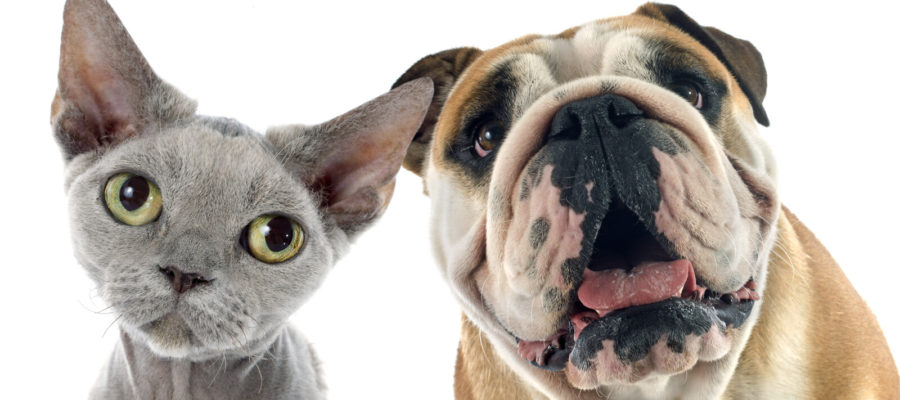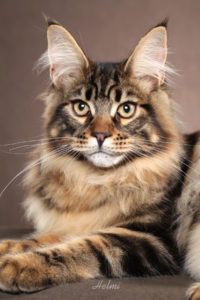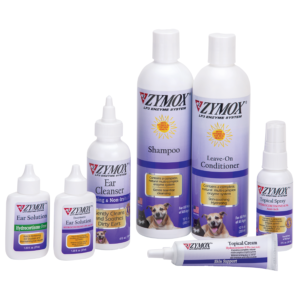Unleashing Relief for Cats and Dogs Prone to Skin Issues

By Arden Moore – The Pet Health and Safety Coach™
What does a hairless Sphynx cat share in common with an English bulldog? Both breeds are prone to skin issues. Any cat or any dog of any breed can encounter rashes, skin allergies, bacterial infections, yeast infections, reactions to new medications and other skin problems but there are some breeds that tend to suffer more than others. Here’s the skinny on pet skin health. Your pet’s skin is the largest organ, representing up to a whopping one-fourth of your pet’s total body weight. That is a lot of surface area to keep maintained and healthy so that they feel comfortable and happy.
Your pet’s skin takes on many roles. For starters, its three layers – epidermis, dermis and subcutis – act as a protective shield. The skin also helps regulate your pet’s body temperature. And, don’t forget the importance of your pet sporting healthy paw pads and manicured nails for easy mobility and gripping.
CAT AND DOG BREEDS PRONE TO SKIN ISSUES
Pets of any breed can have issues that affect their skin such as food and environmental allergies, inherited health conditions, parasite invasions (fleas and ticks), temperature extremes and reaction to stressful situations that can cause excessive licking and ouchy hot spots. In the winter, many indoor cats and dogs can develop dry, flaky skin due to drops of humidity inside the home. Length of hair or lack of hair can also impact a pet’s skin. Here is a brief list of breeds known for their predisposition to skin problems.

CATS
Devon Rex – This shorthaired breed is prone to yeast infections as well as greasy skin and itchy skin.
Maine coons – This hardy cat sports a long, thick coat that needs regular brushing to prevent matted fur. (pictured on right)
Persians – This breed is at risk to inherit a skin disorder called idiopathic seborrhea that causes a foul odor, hair clumps and red, irritated skin. There are two types: oily or dry and flaky.
Sphynx – This hairless feline breed sports large eyes, huge ears, wrinkled skin and a long, skinny tail. Lacking hair can impact this breed’s body temperature. Sphynx cats have cuddle reputations because they snuggle with people or climb under covers to stay warm. They can also develop very greasy skin and an accumulation of wax in the ears.
DOGS
Chinese Shar-Pei and English Bulldog – These breeds sport skin folds that can trap in moisture and lead to yeast and bacterial skin infections.
Doberman Pinscher – Don’t let their smooth coats fool you. This breed battles dry and flaky skin and is prone to hypothyroidism, which can cause dry skin or hair loss.
Poodles – This breed is at risk for a condition that causes hair loss and oily coats called granulomatous sebaceous adenitis.
Spaniels – This breed is afflicted by several things. They are prone to environmental allergies, dermatitis, and seborrhoea which appears like a mix of dandruff and oily skin. Because of their droopy, heavy ears they are can stimulate yeast and bacterial growth.
HOW YOU CAN HELP
One of the best ways to help a pet prone to skin issues is to be proactive. Cats and dogs reap numerous health dividends when you step in on occasion to brush their coats, trim their nails and yes, even give them a bath. Here are some ways you can help keep your pet’s skin and coat at its healthy best.
- Encourage water bowl visits. Cats and dogs need water to properly hydrate the cells, regulate body temperature, aid in the vascular circulation of blood and usher out body waste. Dehydration can contribute to kidney damage, vomiting, seizures and other serious issues.
Veterinarians recommend that cats and dogs should drink at least 1 ounce of water/fluids per pound of pet. So, a 10-pound dog should drink at least 10 ounces of water every day. Ask your vet about flavored pet drinks that replenish electrolytes and other key minerals, especially if your cat or dog is not a big fan of the water bowl.
To check your pet’s hydration status, gently lift some of your pet’s skin from the back of her neck and release. The skin should spring back immediately. This indicates your pet’s skin has good elasticity and serves as a sign that she is getting enough water and is not dehydrated.
- Keep tabs on your pet’s skin from head to tail. At least weekly, glide your open palm down the body, from the head to the base of the tail. Then gently glide from the tail to the head. Be on the lookout for any fleas, matted fur, hot spots, bumps or lumps. Also palpate the abdomen to feel for any lumps or skin tags or signs of discomfort.
 Don’t forget the tail. It contains many tiny bones. Dogs and cats use their tail for balance and to convey moods. Gently glide your hand on the tail and look for any cuts, bumps or bald spots. Also check the anal area for any swelling, redness or oozing.
Don’t forget the tail. It contains many tiny bones. Dogs and cats use their tail for balance and to convey moods. Gently glide your hand on the tail and look for any cuts, bumps or bald spots. Also check the anal area for any swelling, redness or oozing.
Finally, lift each paw and inspect for any cuts or cracks or redness to the paw pads. Make sure each nail is not too long or curving and don’t forget the dew claws, which are located on the inside of each front paw. Regularly trim your pet’s nails to prevent them from overgrowing and getting stuck into carpet or rugs.
- Treat your pet to regular grooming sessions and baths. Being your pet’s personal groomer can help prevent a matted coat and keep the skin and coat healthy. Grooming time also is a good opportunity to take note of anything different or unusual in your pet’s skin. Bathing helps rid your pet of excess hair, grime, germs, dead skin and excessive oils that can build up. It also clears the coat of dust and pollen. One caution: don’t over bathe your pet, as you risk stripping the oils from the coat and drying out the skin.
 When bathing, its important to select the right products. Choose quality shampoos that are free of any artificial dyes, petrochemicals, parabens or sodium lauryl sulphate. The ZYMOX line of veterinarian-approved products features a Shampoo and Leave-On Conditioner which work to gently cleanse, hydrate, and soothe irritated or itchy skin. These pH-balanced bathing products contain proteins, a patented enzyme formulation and vitamin D that are well-suited for challenging skin that may be itchy or inflamed. The ZYMOX line also includes skin topicals to manage hot spots and infected or irritated areas on the body such as body folds, paws, or around the face. You can learn more on zymox.com
When bathing, its important to select the right products. Choose quality shampoos that are free of any artificial dyes, petrochemicals, parabens or sodium lauryl sulphate. The ZYMOX line of veterinarian-approved products features a Shampoo and Leave-On Conditioner which work to gently cleanse, hydrate, and soothe irritated or itchy skin. These pH-balanced bathing products contain proteins, a patented enzyme formulation and vitamin D that are well-suited for challenging skin that may be itchy or inflamed. The ZYMOX line also includes skin topicals to manage hot spots and infected or irritated areas on the body such as body folds, paws, or around the face. You can learn more on zymox.com
 Arden Moore wears many collars in the pet world. She is a best-selling author, master certified pet first aid/CPR instructor, pet behavior consultant, host of the Oh Behave Show on Pet Life Radio and happy pet parent to a Furry Brady Bunch in Dallas. Learn more at www.ardenmoore.com.
Arden Moore wears many collars in the pet world. She is a best-selling author, master certified pet first aid/CPR instructor, pet behavior consultant, host of the Oh Behave Show on Pet Life Radio and happy pet parent to a Furry Brady Bunch in Dallas. Learn more at www.ardenmoore.com.

